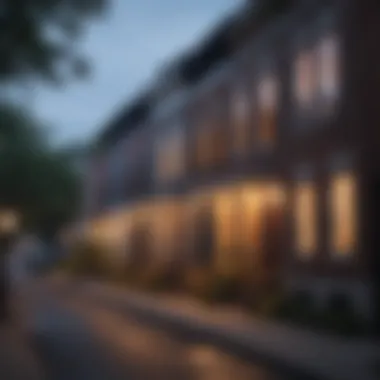Navigating Rentals in the District of Columbia


Intro
When the big lights, rich history, and vibrant culture of the District of Columbia beckon, many find themselves combing through the rental market in search of the perfect home. Renting in DC isn’t just about finding a place to hang your hat; it’s about immersing yourself in the pulse of a city that has seen it all. This guide unfolds the layers of houses for rent, carefully dissecting the neighborhoods, architectural wonders, and practical steps necessary to navigate this unique landscape.
"DC isn’t merely a city; it’s a tapestry of experiences waiting to be explored."
The rental scene in the nation's capital is dynamic, boasting a varied array of options tailored to distinct tastes and lifestyles. Whether you're a first-time renter or someone familiar with the intricacies of urban living, this exploration aims to underscore key factors like location, design, and real estate trends that play pivotal roles in housing decisions. Let’s roll up our sleeves and dig into the heart of renting in DC.
Featured Homes
Finding a house for rent in this diverse city often leads to some architectural gems that reflect the rich fabric of DC. It’s not just about the walls and roof; it’s about the stories they tell.
Architectural Styles
From Victorian brownstones lining the streets of Capitol Hill to modern duplexes in NoMa, the architectural styles in DC truly stand out. Each neighborhood tends to reflect its character through its structures.
- Colonial Revival: This traditional style is prevalent in neighborhoods like Georgetown, offering charm with its symmetrical shapes and classic brick facades.
- Art Deco: Found in some parts like the U Street Corridor, these buildings feature sleek lines and bold graphic details, echoing the vibrance of the 1920s.
- Modern Construction: Areas such as the Wharf showcase cutting-edge design, catering to a crowd that appreciates contemporary aesthetics with eco-friendly features.
Unique Design Elements
Not only do the outsides of these homes fascinate, but many houses boast unique internal elements as well.
- Exposed Brick Walls: Often found in loft-style rentals, these walls add a touch of character and history to the living space.
- Bay Windows: Common in Victorian homes, bay windows allow for ample natural light, creating a warm, inviting atmosphere.
- Luxurious Fixtures: Many homes come outfitted with state-of-the-art kitchens or spa-like bathrooms, catering to renters who desire a touch of luxury.
As one can see, the houses available for rent possess varied characteristics that promise a unique living experience, tailored just for you.
Incredible Locations
DC's neighborhoods are as diverse as the rental homes within them. Each area offers something unique, punctuated by its own geographic and cultural highlights.
Geographic Highlights
The city's layout is rich with scenic views and intriguing geography. From the Potomac River to the National Mall, the environment creates both visual and experiential opportunities.
- Capitol Hill: Nestled close to the heart of governmental power, this neighborhood provides an oak-lined charm and easy access to public parks.
- Downtown: A bustling hub filled with skyscrapers where the rhythm of the city can be felt, it presents endless business and recreational opportunities.
- Adams Morgan: Known for its vibrant nightlife and artistic flair, this area is peppered with colorful buildings and eclectic eateries.
Cultural Significance
Each neighborhood carries its own cultural weight, contributing to the overall ambiance of the District.
- Georgetown: Not only historic, but offers a glimpse into the past with its cobblestone streets and boutique shops frequented by tourists and locals alike.
- The National Mall: A living museum, the Mall offers experiences steeped in American history and art, making it a backyard for those living nearby.
- Dupont Circle: This vibrant district is known for its cultural diversity, art galleries, and a strong sense of community.
The breadth of options offered across the District of Columbia's neighborhoods means that prospective renters will have no shortage of choices, each imbued with its own spirit.
Prolusion to 's Rental Market
The rental market in the District of Columbia is a unique ecosystem shaped by various factors. A closer look at this arena unveils the fusion of rich history and modern living. Knowing how DC’s rental scene works is vital for anyone considering making this city their home.
Navigating through various rental options can feel as tangled as a plate of spaghetti. Understanding the current trends and demographics helps in making informed choices. From single-family houses to chic apartments, each option tells a story about the neighborhood and its residents.
In a city known for its cultural vibrancy and political prestige, the rental market reflects a blend of diversity and dynamism. This makes it not just about finding a place to live but finding the right fit for one’s lifestyle.
Overview of the District of Columbia
The District of Columbia, often abbreviated as DC, is more than just the seat of the United States government. It boasts a myriad of neighborhoods, each with its own character—from the historic avenues of Capitol Hill to the lively streets of Adams Morgan.
DC is essentially divided into quadrants, with each offering a distinctive vibe and amenities. There's the affluent feel of Georgetown, famous for its cobblestone streets and upscale boutiques, juxtaposed against the artistic flare found in neighborhoods like U Street Corridor. Renters can find their niche amongst these varied environments, ensuring that every lifestyle preference is catered to.
Additionally, the District's comprehensive public transport system makes it a cinch to traverse the area. The accessibility offered by the Metro can be a central factor when searching for a rental property.
Current Trends in Renting


The city’s rental dynamics have seen notable evolution in recent years. For instance, one of the more pronounced trends is the shift towards flexible leasing options. Short-term rentals are gaining traction, particularly in areas frequented by tourists and seasonal visitors. This adaptability often appeals to those who cherish freedom, allowing them to experience different neighborhoods without the commitment of a long lease.
Moreover, a surge in remote work has reshaped renters' priorities. Many individuals are now looking for homes with dedicated office spaces, favoring comfort and functionality.
Another aspect worth noting is the impact of technology on the search for rental properties. Online platforms like Facebook Marketplace and Craigslist have transformed how people browse listings, making it easier to connect with landlords directly. Sites often include virtual tours, helping prospective renters get a feel for a place before even stepping foot inside.
"The modern renter is savvy and informed; they value convenience and flexibility unlike ever before."
All these trends indicate a market that’s not just growing, but evolving—adjusting to the needs and wants of a diverse group of renters. As such, ensuring clarity about these dynamics is crucial for those trying to navigate the bustling rental landscape in the capital.
Variety of Housing Options
When delving into the rental landscape of the District of Columbia, one can't overlook the variety of housing options available. This diversity caters to various lifestyles, budgets, and preferences, making it essential for prospective tenants to comprehend the types of homes that fit their needs. Finding the right housing means more than just having a roof over one’s head—it's about choosing a place that feels like home, aligns with one’s work and leisure activities, and is within budget.
Each housing type in D.C. has its own unique characteristics. That could be the spacious nature of a single-family home or the vibrant community feel of an apartment complex. Knowing these distinctions can aid renters in making an informed decision. A person considering a move might ask, "Do I need space for a growing family, or am I looking for something cozy just for myself?" Identifying your priorities up front can make all the difference in navigating this bustling market.
Single-Family Homes
Single-family homes in the District often boast ample space and privacy, attracting families and individuals alike. In neighborhoods such as Capitol Hill and Forest Hills, you’ll find larger homes with backyards, perfect for those who value outdoor space or need room for children to play.
One key consideration with single-family homes is the responsibility of maintenance. Renters often have to think about not just living space but also yard upkeep which can add both time and cost. Yet, the trade-off can lead to a more personalized living experience. Single-family homes may also be in quieter areas compared to multi-family dwellings, appealing to those seeking a bit of tranquility amidst the city’s bustle.
Apartments and Condos
Apartments and condos are almost a dime a dozen in D.C., with choices ranging from modern high-rises in Downtown to historic buildings in Logan Circle. These dwellings primarily attract young professionals and those who prefer to be close to the action.
Living in an apartment often offers convenience; many come equipped with amenities such as gyms, pools, and community lounges. However, renters may need to balance the vibrancy of apartment life against potential downsides like noise from neighbors or limited parking availability. Choosing a condo might afford a bit more privacy, with many offering their own unique perks.
Townhouses
Townhouses present yet another appealing option for those looking at the District. More compact than single-family homes yet spacious compared to apartments, townhouses blend both worlds. Places like Adams Morgan and Dupont Circle are known for charming piers of townhouses that often feature character and unique architectural designs.
Tennants may appreciate the close-knit feel that townhouses can offer, often sharing walls with neighbors while enjoying their own private spaces. Common considerations include shared community spaces and possibly working with homeowners' associations, which can sometimes limit how you might use the property. Understanding these community dynamics can help renters find a cozy haven that fits their lifestyle while still enjoying the sense of community.
Overall, the variety of housing options in Washington, D.C., means that there's truly something for everyone. By deeply considering personal needs and wants, prospective renters can confidently step into the market, making selections that feel right for their individual situations.
Neighborhoods to Consider
When venturing into the rental landscape of the District of Columbia, understanding the neighborhoods is crucial for any prospective renter. Each area has its own character, influence on lifestyle, and unique selling points. Renting in the right neighborhood can make a significant difference; it affects commute times, social interactions, and even property values.
Key elements to consider include:
- Community Vibe: The atmosphere of a neighborhood can shape daily living—from the lively streets of Adams Morgan to the more historic charm of Georgetown.
- Accessibility: Proximity to public transport, major roadways, and even workspaces plays a role in selecting a suitable location. A neighborhood that’s easy to navigate can save time and reduce stress.
- Amenities: Close access to parks, restaurants, and shopping can enhance quality of life.
- Safety: It’s wise to research crime rates and community programs that work towards maintaining safety in the area.
Renters should weigh these factors carefully. The right neighborhood can enhance not just your living experience, but also your long-term satisfaction in a new home.
Capitol Hill
Capitol Hill stands as one of the most iconic neighborhoods in DC, with tree-lined streets and historic row homes where shadows of American history linger. This area is home to many political figures and civil servants, giving it a profound sense of community.
Live here if you appreciate a blend of history and local culture. The proximity to landmarks like the United States Capitol and the Library of Congress adds a level of prestige to your address. The thriving Eastern Market, hosting a farmer's market and local artisan vendors, is a pivotal hub for residents seeking fresh produce and crafts. This neighborhood often has a lower turnover rate, indicating a strong community spirit—something invaluable for renters.
Georgetown
Georgetown is perhaps the poster child for luxurious living in DC. With its cobblestone streets and beautifully preserved architecture, it's no wonder that this neighborhood attracts those with a taste for the finer things in life.
The charm of Georgetown isn’t just about how it looks; it offers numerous high-end boutique shops, exquisite dining experiences, and picturesque waterfront views. For culture seekers, the area boasts a vibrant arts scene, home to galleries and performance spaces. The Georgetown University adds a youthful energy, stirring life into an otherwise historic frame. Renters will appreciate this blend, but they should also be prepared for higher rental costs associated with such luxury living.
Adams Morgan
Adams Morgan is a kaleidoscope of cultures and experiences making it one of the most eclectic neighborhoods in the city. Known for its lively nightlife and vibrant arts, this area is ideal for those who enjoy a bustling social scene. The proximity to cultural influences is glaring, with an array of international eateries and community events.


Don’t let the hustle overshadow the charm—Adams Morgan hosts a number of quiet residential streets as well. This balance makes the neighborhood accessible for young professionals and families alike. Also, be sure to check out the annual Adams Morgan Day festival, which celebrates the neighborhood’s artistic and cultural diversity. It’s not just a place to stay; it’s a lifestyle choice.
Dupont Circle
Dupont Circle is where historic elegance meets modern vibrancy, offering a blend of old-world charm with contemporary amenities. The roundabout’s park is a favorite spot for locals, and nearby cafes provide the perfect backdrop for casual meetings or leisurely afternoons.
This neighborhood is a hub for professionals, with a variety of rentable spaces—from chic condos to multifamily units. Furthermore, the Dupont Circle area features great public transportation options, making the commute to any part of the city a breeze. It’s an attractive choice for those who need to balance work and leisure effectively. Plus, its proximity to cultural landmarks keeps residents connected to the heartbeat of DC.
Factors Influencing Rental Prices
Understanding the elements that influence rental prices in the District of Columbia is crucial for anyone considering the rental market here. Prices fluctuate not only based on the property's physical characteristics but also through various external factors like neighborhood desirability and market dynamics. Knowledge of these factors helps renters make educated decisions, enabling them to find a home that fits their budget while also meeting their lifestyle needs.
Location and Accessibility
The saying "location, location, location!" echoes loudly in real estate, particularly in Washington, D.C. Homes that are situated closer to major transport hubs, such as Metro lines and bus routes, tend to command higher prices. This is due to the convenience of commuting to work or accessing the city's rich tapestry of cultural, historical, and social amenities.
- Neighborhoods: Renowned neighborhoods such as Georgetown or Logan Circle, with their blend of charm and walkability, often see a surge in rental prices. Renters are often willing to pay a premium for the vibrant atmosphere, easy access to cafes, parks, and entertainment.
- Public Transport: Proximity to public transport is non-negotiable for many renters. If a home is located within a few blocks of a Metro station, the demand can drive rental prices up, as fewer people would like the hassle of long commutes.
Market Demand and Supply
Market demand plays a pivotal role in setting rental prices. When the demand for homes surges, especially during peak moving seasons, landlords are likely to increase prices.
- Seasonality: Traditionally, summer months may see a spike in rentals as college students and families look to relocate. However, winter can sometimes offer lower prices due to less competition.
- Supply Chain Issues: The recent trends in construction and housing development can also impact rental prices. If permits are delayed or projects are stalled, potential housing shortages can lead to increased prices for available rentals.
"Rental prices often reflect the real-time pulse of the economy. Keep an eye on local job growth and economic trends; they can tell you a lot about future rental pricing."
Property Features and Amenities
The features and amenities offered by a rental property can sway prices dramatically. Renters often seek dwellings that not only provide shelter but also enhance their living experience.
- Modern Conveniences: Properties that come equipped with updated kitchen appliances, in-unit laundry facilities, or smart home technology can see a price boost. Additionally, homes with attractive outdoor spaces—like patios or rooftop gardens—are increasingly sought after, especially in urban environments.
- Building Amenities: Access to building features such as gyms, pools, or communal workspaces can lead to higher rental costs. Today's renters often value lifestyle-oriented amenities that cater to their everyday needs.
In summary, the interplay between location, market dynamics, and the specifics of a property significantly affects rental pricing in D.C. A thorough understanding of these dynamics can guide renters toward more viable options while ensuring they find a home that meets their financial and personal needs.
Rental Process in
Navigating the rental process in Washington, D.C., can be a real maze. It’s not just about finding a property; it’s about understanding the whole dance of renting. Grasping the rental process aids potential tenants in making informed decisions and helps them avoid any pitfalls along the way. Having a solid strategy can save time, effort, and possibly even money.
Finding a Rental Property
When it comes to finding a rental property in D.C., the first step is to be clear about your needs. Consider what you want in terms of location, size, and budget. This city offers a plethora of options, from modern high-rises to historic brownstones. Websites like Zillow and Craigslist are popular, but don’t overlook local real estate agents, who often have inside scoop on upcoming listings.
Some tips for hunting:
- Explore various neighborhoods: Each offers a unique vibe. From the historic streets of Capitol Hill to the buzz of Adams Morgan, understanding the area is key.
- Use social media groups: Platforms like Facebook have groups specifically for D.C. rentals, where landlords and communities post available properties.
Application Requirements
Once you’ve spotted a potential property, the next hurdle is the application process. D.C. landlords typically require several documents, and having these ready can speed things along. Key items often include:
- Credit report: A good score can give you an edge.
- Proof of income: Be prepared to show pay stubs or bank statements.
- Rental history: References from past landlords can help.
Knowing what to expect and getting these documents in order can streamline the application process and give you a better shot at landing the place you want.
Lease Agreement Essentials
If your application is approved, it’s time to sign a lease. This document outlines the terms of your rental, so understanding its content is vital. Here are key elements to pay attention to:
- Duration of the lease: Standard leases are typically for a year, but options exist for shorter or longer terms.
- Rent due date and payment methods: Make sure you know when and how to pay.
- Security deposit details: Understand how much you’ll need to pay upfront and under what conditions it'll be returned.
- Maintenance responsibilities: This specifies who handles repairs and when.
- Early termination clause: Life happens, and knowing your options is crucial.
Being well-versed in these aspects ensures that you’re not signing away your rights or agreeing to unfavorable conditions.


"Awareness is the first step in the journey of renting. It empowers you to make smart decisions."
Understanding the Regulations
Navigating the landscape of rental properties in the District of Columbia is not just about finding the right home; it's equally about comprehending the underlying framework of regulations that govern tenant-landlord relationships. For renters, understanding these regulations can provide peace of mind and empower them to make informed decisions. The District has unique laws designed to protect tenants, reflecting its commitment to fostering a fair housing environment.
Tenant Rights
Tenant rights in DC come with a strong backing. These rights are crucial for maintaining a balanced relationship between landlords and tenants. Key rights that renters should be aware of include:
- Right to a habitable home: In simpler terms, your rental unit must be safe and livable; think of it as a necessity rather than a luxury.
- Protection against discrimination: One can't be denied housing simply based on race, gender, familial status, or disability. This is not just ethical; it's the law.
- Proper notice for evictions: If a landlord wants to kick you out, they can't just change the locks overnight. They must provide legally mandated notice periods, giving tenants a fair chance to respond or rectify the situation.
Furthermore, the Tenant Advocate office in DC is a valuable resource, providing information and support for renters navigating disputes or needing assistance. As a tenant, leveraging these rights can bolster your position when dealing with tricky scenarios.
Fair Housing Laws
Fair Housing Laws serve as the backbone of the rental market's regulations, ensuring that everyone has access to housing without facing discrimination. The federal Fair Housing Act, combined with local laws specific to DC, creates a web of protections intended to level the playing field. Here are some essential aspects of these laws:
- Wide-ranging scope: These laws apply to nearly all multifamily housing units and many single-family homes, making it clear that discrimination is not tolerated in any form.
- Legal recourse available: If you feel you've been wrongly turned away from a rental opportunity, myriad legal options exist. You can file a complaint with the DC Office of Human Rights, which takes discrimination allegations seriously.
- Annual training for landlords: Landlords in DC are mandated to undergo training on fair housing laws. This not only creates awareness but also ensures compliance, ultimately benefiting tenants.
"Understanding and advocating for your rights is not just empowering; it's essential for navigating the rental landscape effectively."
In summary, being well-versed in tenant rights and Fair Housing Laws equips renters with the necessary tools for asserting themselves in the rental market. With these regulations in your back pocket, you'll navigate the ins and outs of renting in DC with confidence and clarity.
Insights from Real Estate Experts
Understanding the insights offered by real estate experts is crucial for anyone navigating the rental landscape in the District of Columbia. Their knowledge stems from years of experience, market analysis, and hands-on engagement within the ever-evolving rental market. In this article, we will delve into two main aspects provided by these authorities: market predictions and advice for renters. By exploring these elements, potential tenants can make more informed decisions and adapt their strategies when searching for a house to rent.
Market Predictions
Real estate experts often analyze current trends, housing stock, and economic indicators to project future movements in the rental market. When it comes to the District of Columbia, several factors can impact these predictions:
- Economic Conditions: A strong job market generally correlates with increased demand for rental properties, often leading to rising rent prices. Conversely, economic downturns can stabilize or even lower rents, creating opportunities for renters.
- Population Trends: An influx of people moving into DC, whether for jobs or education, tends to increase rental demand. Experts predict that as remote work becomes more common, DC may see a shift with people relocating from other parts of the country, which could lead to competitive bidding for rentals.
- Legislative Changes: Understanding changes in housing regulations or zoning laws can also affect rental prices and availability. For instance, proposed laws to increase affordable housing can lead to fluctuations in the market, making it important for renters to stay informed.
When considering insights from professionals, always keep your ear to the ground. Attend local real estate seminars or follow updates from organizations such as the DC Association of Realtors. These resources can offer valuable foresight into the rental market.
"Understanding market predictions isn’t just about knowing the numbers; it’s about anticipating shifts and making choices that align with those projections."
— Real Estate Analyst, District Insights
Advice for Renters
Real estate experts also provide practical advice to help renters navigate the competitive landscape. This advice often combines market knowledge with personal anecdotes, making it invaluable for prospective tenants. Here are some of the key points:
- Start Your Search Early: The earlier you begin looking for a rental, the better your chances of finding a place that fits your needs. Experts recommend starting your search at least two to three months prior to your desired move-in date.
- Know Your Budget: Before even looking at rental properties, have a clear understanding of your financial situation. Include all potential expenses such as utilities, internet, and renters insurance when calculating what you can afford.
- Be Flexible: Sometimes, you may have to compromise on certain aspects. Perhaps you might want a two-bedroom apartment in Georgetown, but a one-bedroom could be easier to secure and fit within your budget. Flexibility in your outlook can open doors that were previously unconsidered.
- Maintain Good Communication: When dealing with landlords or leasing agents, clear and timely communication is key. Build rapport and ensure your questions are answered. This not only builds trust but could also strengthen your application.
- Understand the Fine Print: Lease agreements can be tricky. Pay attention to clauses regarding rent increases, security deposits, and maintenance responsibilities. If anything seems unclear, don’t hesitate to seek legal advice.
Following this seasoned advice can truly be a lifeline in a competitive rental market like DC's, helping you navigate challenges and secure a home that best meets your needs.
By integrating expert insights into your rental strategy, you can look forward to a more straightforward and successful journey in finding a rental home in the District of Columbia.
Culmination
In navigating the rental landscape of the District of Columbia, it’s vital to grasp not just the numbers but the essence of what renting means in such a dynamic environment. The importance of understanding this topic lies in its multifunctional nature; a blend of historical richness, diverse neighborhoods, and evolving market trends all come together, shaping the experience prospective renters will have.
Summarizing the Rental Landscape
To wrap things up, DC presents a rental market that’s ever-changing and multifaceted. Various housing types reflect the city’s diversity; from quaint townhouses nestled in historic districts to sleek, modern apartments overlooking the Anacostia River, there is truly something for everyone. Rental prices can fluctuate widely, driven by neighborhood desirability, property conditions, and indeed, overall market demand. Recently, there’s been an uptick in interest in older, more traditional homes, reflecting a shift in renter preferences as they seek unique character amidst modern amenities.
In terms of local culture, factors such as the proximity to amenities, schools, and transportation options greatly enhance the attractiveness of current listings. Renters must keep a keen eye on these aspects; housing in well-connected neighborhoods often commands a premium, but can also offer superior lifestyle advantages.
Final Considerations for Prospective Renters
As you embark on your rental journey in DC, a few core considerations can pave the way for a smoother experience. First, consider your lifestyle—is access to nightlife important? Or perhaps green spaces for leisurely strolls are a priority? Define your must-haves early on, which will streamline the property search.
Second, understand your budget. The last thing you want is to fall in love with a property that drains your wallet faster than you can say "neighborhood charm". Assess your finances honestly and factor in all potential costs, including utilities, parking, and even internet, since these can add up.
Lastly, don’t underestimate the power of local insights. Engaging with current residents through platforms like Reddit can provide valuable information about living in specific neighborhoods, including potential pitfalls to watch out for.
"Renting is not only about finding a roof over your head; it’s about discovering the fabric of the community around you."















